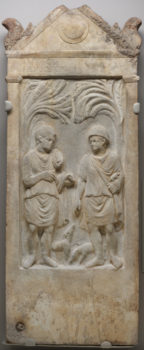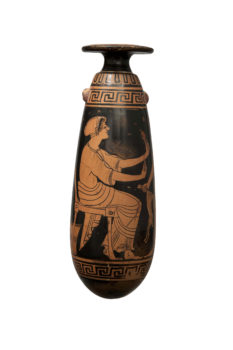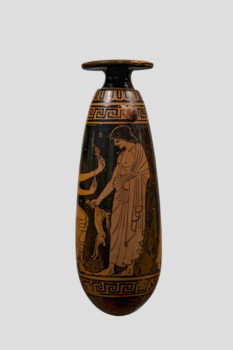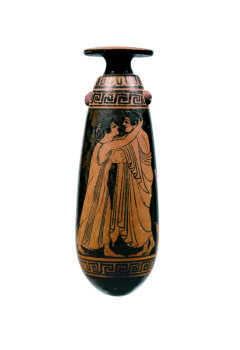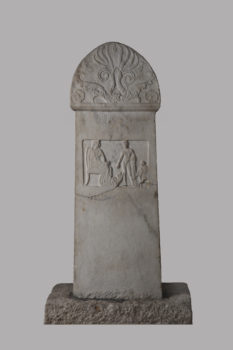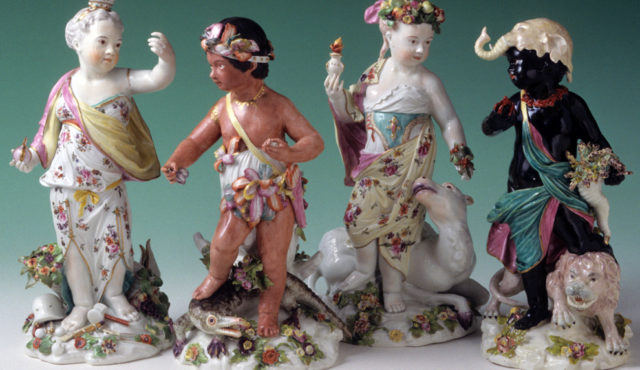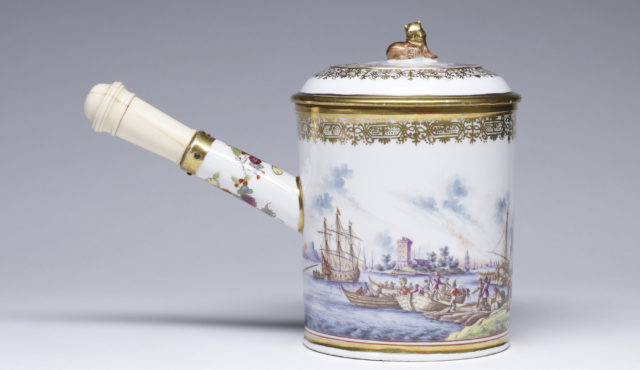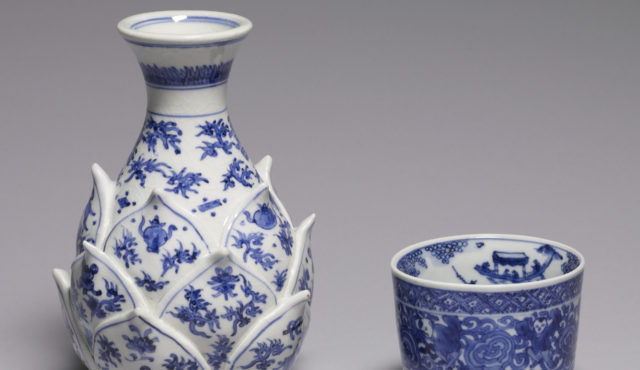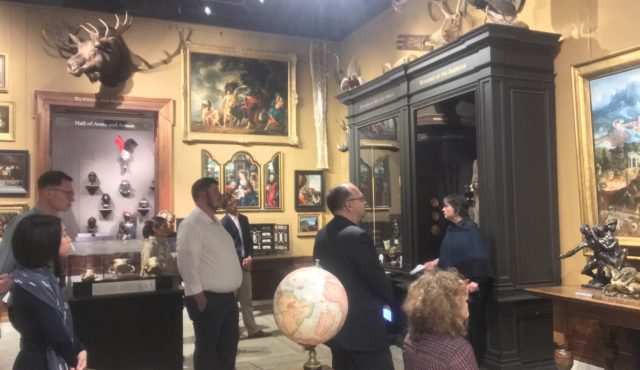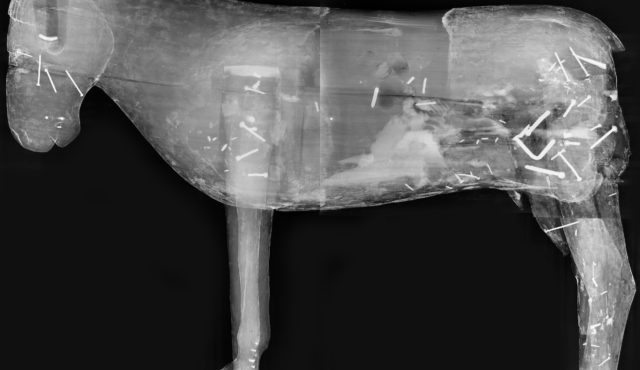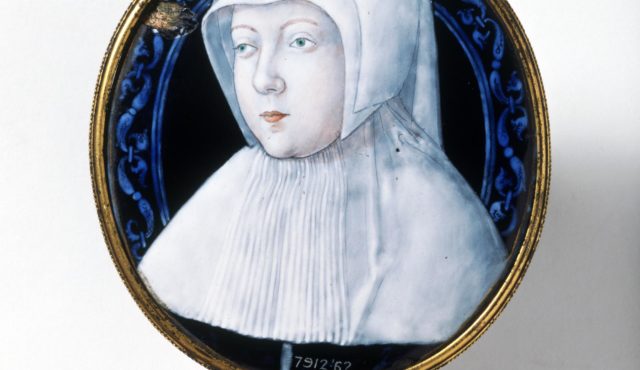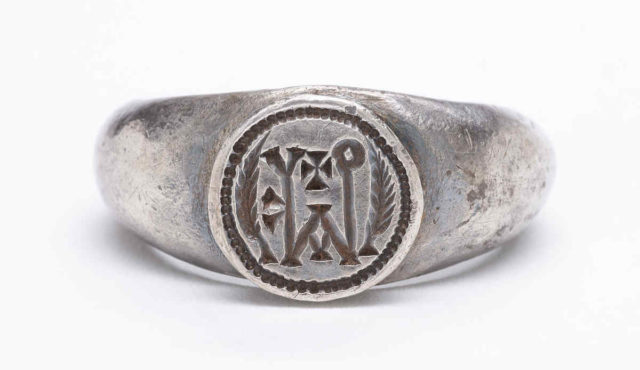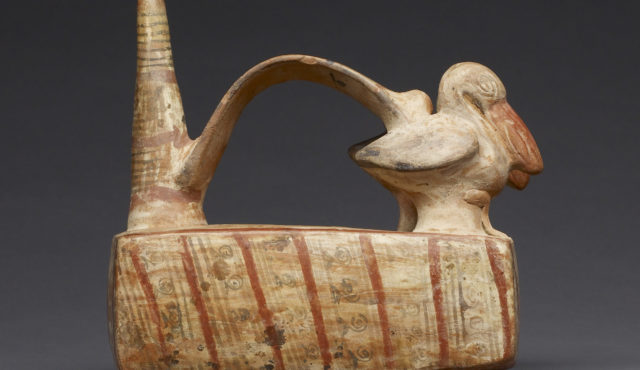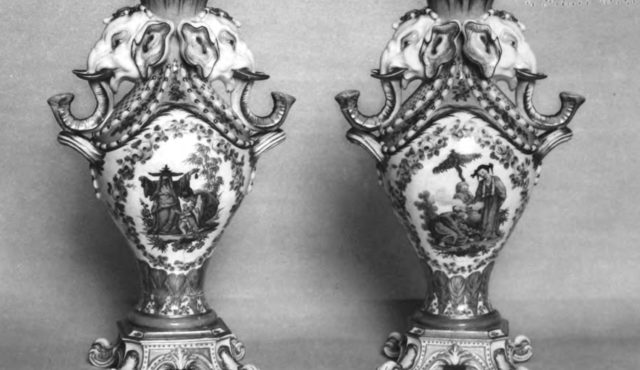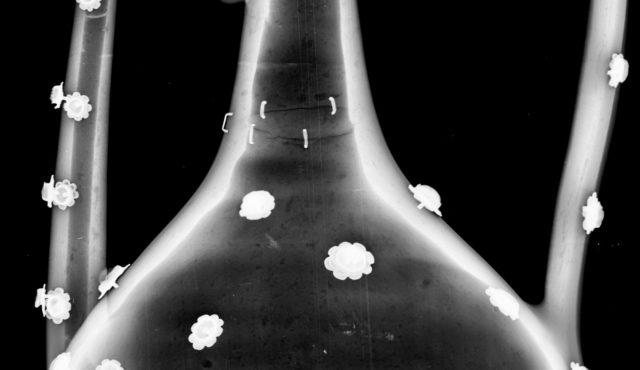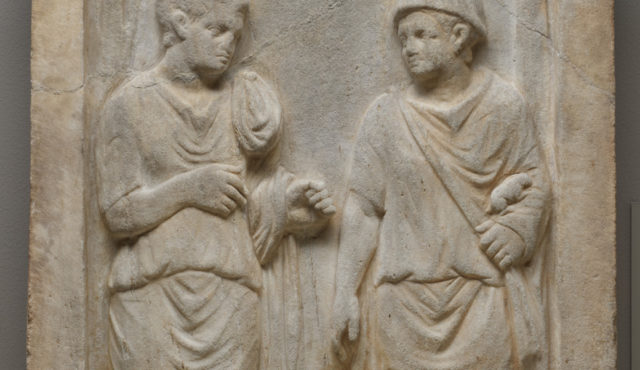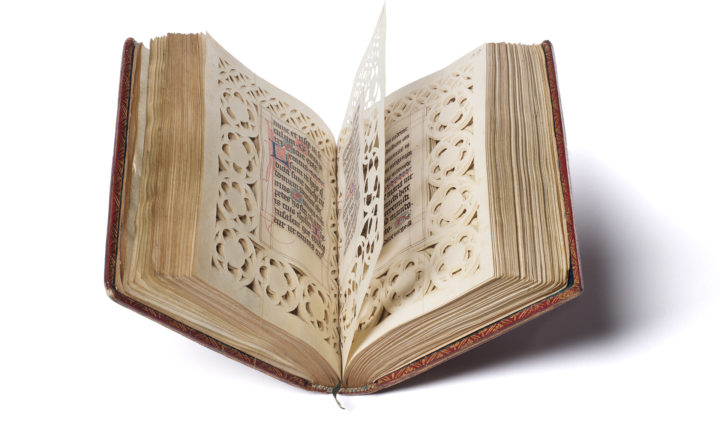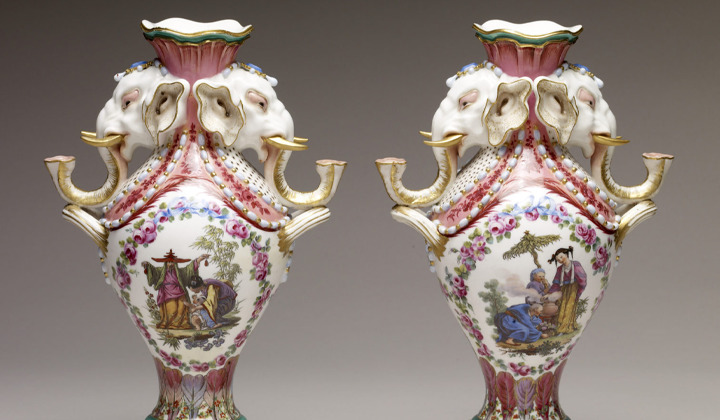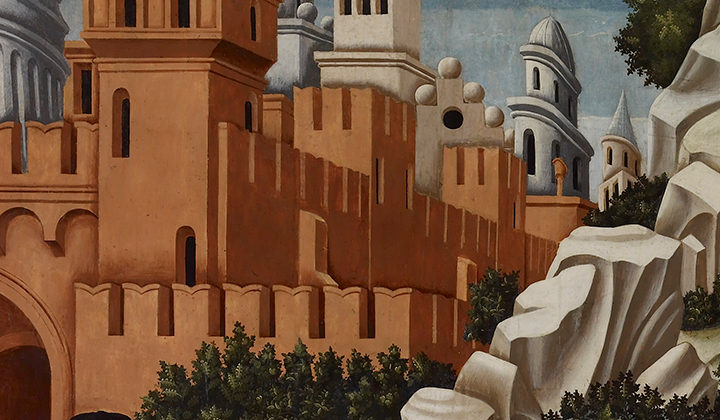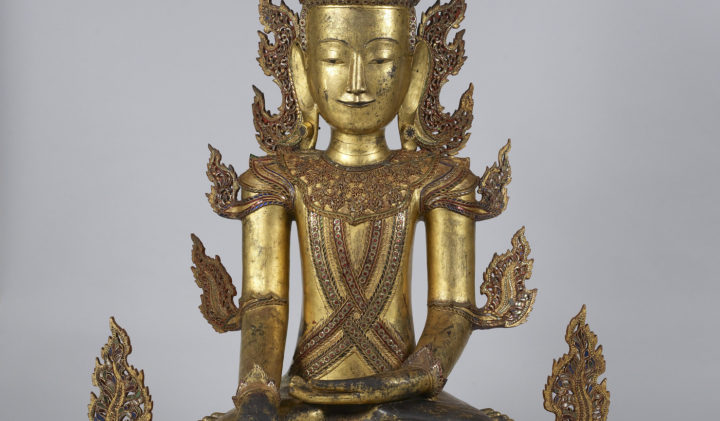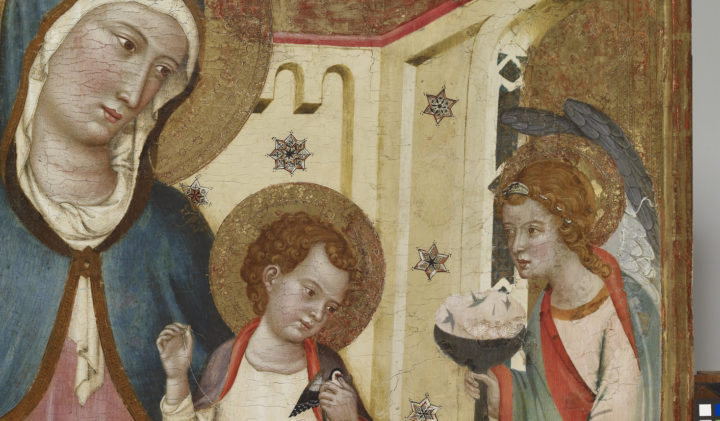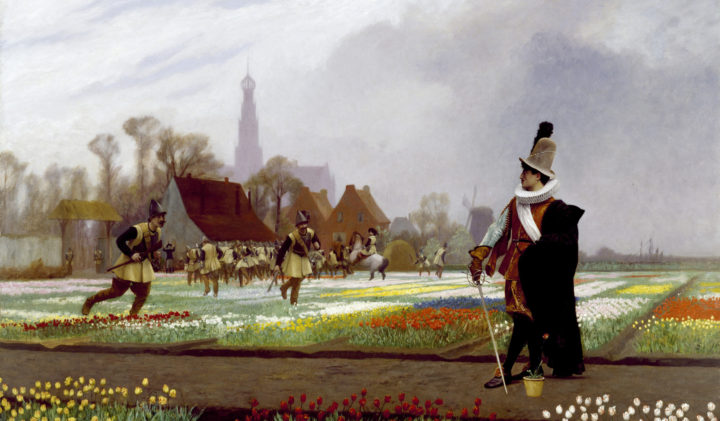In 1924, Henry Walters purchased a marble funerary stele (tombstone) from the Joseph Brummer Gallery in New York (fig.1).[1] Depicting two men, the stele is believed to have been created in the region of Attica, Greece, during the first to second century CE (Roman Imperial period).[2] The form and decoration of this stele are typical of Roman-period Attica. The overall shape is inspired by a naiskos (small Greek temple), with a triangular pediment at the top, decorated on each side by a simplified curving antefix (ornamental fixture placed on the eaves or cornice of a building); in the center of the pediment, a patera (shallow dish for pouring liquid libations) is depicted in relief. Directly below that and supported by two stylized columns with capitals, a narrow rectangular entablature bears a two-line inscription in Greek naming one of the men as Antaios Meilesios (Antaios the Milesian).[3] The blank right side of the entablature leaves room for the name of the second man, but, for reasons unknown, it was never added. The main portion of the stele is a rectangle, framed on the left and right by these columns and at the bottom by a smooth, uncarved section. Within this frame are two beardless men wearing tunics, cloaks, and ankle-high boots who stand facing each other; the man on the left has a bare head, while the man on the right wears a simple domed helmet or pilos (hat). Their clothing is consistent with a Roman-period date for the stele. Two dogs are shown at the men’s feet—the one on the right raises its head to the hand of the helmeted man, while the one on the left touches its nose to the ground; the dogs allude to hunting and cast the two men in the role of hunters.
There are two unusual iconographic elements in the composition. The first, and still largely inexplicable, is the carved background of two date palm trees.[4] The second, which will be the focus of the rest of this note, is the presence of a small hare cradled in the left arm of the man at right, which suggests that the two men were romantic partners. To contextualize this interpretation, the first section of this note gives a brief overview of ancient Greek depictions of courtship, with particular emphasis on the role of animals as “love gifts,” followed by an equally brief look at Greek tombstones from the Classical to Roman periods and the difficulties of interpreting the relationships among the individuals depicted together on a tombstone or funerary monument. Finally, a brief discussion of other depictions of courtship on Greek tombstones that include hares as love gifts provides a framework for understanding the tombstone of Antaios.
The Iconography of Courtship on Greek Vases
Same-sex relationships, particularly in the Greek world, have been explored extensively and will be discussed only briefly here.[5] These relationships are alluded to in ancient literature and shown sometimes explicitly on vessels.[6] While there is often the assumption that male same-sex relationships were condoned in ancient Greek society, the reality was much more limited.[7] In the most accepted form, an older man (erastes) could have a relationship with a younger man (eromenos) that would last only until the younger man reached maturity, at which point the younger man would take on the role of erastes and pursue a relationship with a new eromenos. These relationships did not preclude either man from being married to a woman during the relationship or later, and although the relationships were not supposed to continue into adulthood, some certainly did.[8]
Many black- and red-figure vessels of the sixth to fifth century BCE (Archaic to Classical periods) include images of older men courting young boys; the figures sometimes kiss or embrace one another.[9] Many vases show a young man alone, depicted as a “beautiful boy” (explicitly labeled as such in painted inscriptions), that is, as a desirable eromenos—always youthful, frequently nude, and sometimes seductively posed.[10] An important iconographic element of courtship was one partner giving an animal as a love gift to his beloved; this could take the form of showing one person actively giving the animal while the other receives it, or simply a depiction of one lover alone holding a gift. Roosters were the most common animal to be given as a love gift, due to associations with virility, combativeness, the aristocracy, and even eroticism.[11] But hares, which are fast, elusive, cunning, and highly fertile, were the second most popular animal love gift.[12] Hares and dogs commonly appear in scenes depicting the hunt, and, in Greek art, a direct iconographic connection is established between hunting and courtship “to create the metaphor of courtship as hunting,” where the erastes acts as the hunter pursuing the eromenos as his prey.[13] Depictions of opposite-sex courting also appear on vases, and animal love gifts are exchanged in them as well. A red-figure alabastron (small perfume or oil vessel) from an early fifth-century BCE grave in the Kerameikos cemetery of Athens shows a young man presenting a hare to a seated woman, while on the other side, the man and woman embrace (fig. 2).[14] The depiction of an animal love gift, such as a rooster or a hare, actively changing hands or simply being held by one of the figures makes a clear allusion to courtship and a sexual relationship that would have been understood by Greek viewers.
Relationships on Greek Tombstones
Attic marble tombstones and funerary sculpture of the Classical period (early fifth to late fourth century BCE) share the visual language of ceramic vessels, including in the ways that interpersonal relationships were depicted. Let us first consider a brief overview of common depictions of multiple people on one stele as well as how the relationships between the people are interpreted, and then turn to the rare depictions on tombstones that could be considered instances of courtship. Although the tradition of using marble figural tombstones was not continuous over the centuries, the imagery of sculptural funerary monuments persisted in Attica from the Classical period into the Roman Imperial period (late first century BCE to third century CE).[15] Attic tombstones generally bear an image of the deceased, sometimes accompanied by other individuals, who have often been identified as servants[16] or as family members.[17] Some tomb monuments commemorate entire families.[18] The figures frequently clasp right hands, a gesture referred to as dexiosis, although in other instances they do not interact at all.[19] Except when the figures are identified as servants, scholars generally accept that the individuals depicted had some meaningful personal relationship with each other. Surviving inscriptions sometimes fully describe the associations among the persons depicted by giving their names and family relationships, yet on many tombstones, the names as inscribed indicate no familial relationship, which makes interpreting the relationships among the individuals much more difficult.
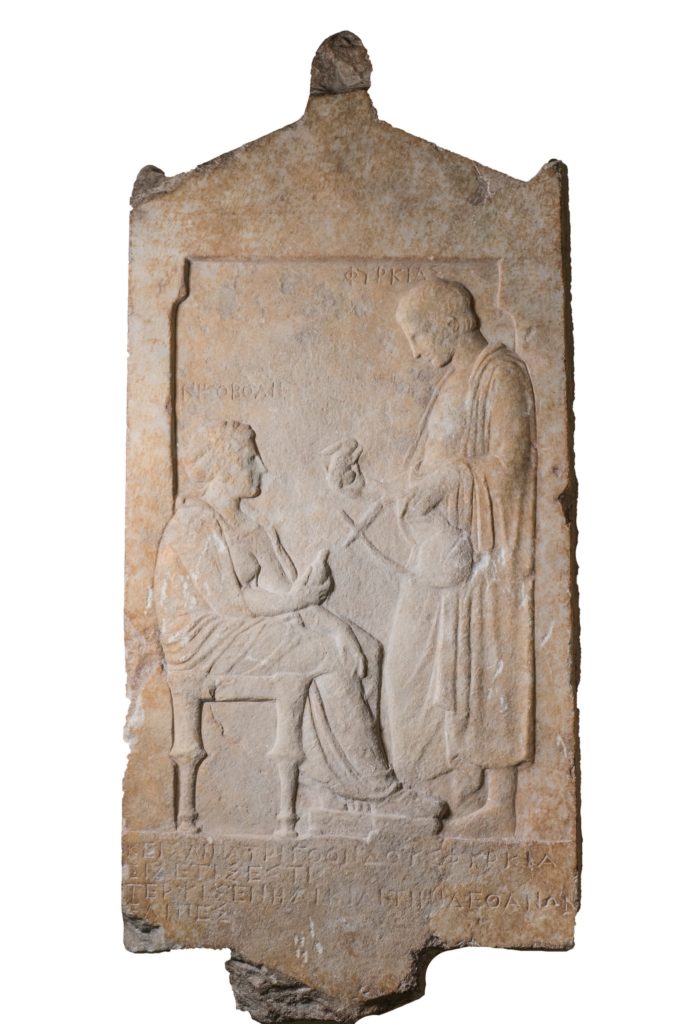
Funeral Stele of Phyrkias and Nikoboule, Greek, late 5th–early 4th century BCE, marble. Archaeological Museum of Piraeus, acc. no. MP3499. © Hellenic Ministry of Culture and Sports.
When figural funerary monuments do not have labeling inscriptions to help determine the relationships among the individuals represented, as in the case of Antaios’s stele, scholars have tended to ignore the possibility that a tombstone might depict a romantic relationship, even if other elements of the iconography might support such an interpretation. Classical historian Sian Lewis notes “an interesting reluctance to credit the idea of courtship” scenes appearing on funerary stele and monuments, whether between same-sex or opposite-sex couples, stating that “one has to wonder whether the apparent rarity of courting as a theme on funerary stelai is in fact the result of modern commentators’ unwillingness to consider the idea when the relationships between the figures are unclear.”[20] One work to look at for this “reluctance,” simply due to the huge number of funerary works under consideration, is Swiss archaeologist Christoph Clairmont’s multivolume corpus Classical Attic Tombstones (1993), which is still the most thorough analysis of Attic funerary monuments. In this work, Clairmont collects data and images for thousands of tombstones, providing commentary and a full scholarly bibliography for each. In assessing each tombstone, when more than one person is shown, Clairmont attempts to classify the relationships among the individuals depicted—he interprets figures shown together on tombstones, almost by default, to be family (related by blood, adoption, or marriage), even when there is no supporting evidence from inscriptions or iconography. Rarely, Clairmont postulates very general relationships like “companions” or “close friends.”[21]
The following four funerary monuments, each of which includes a hare, are best interpreted as examples of courtship between opposite-sex couples. The funerary stele of Phyrkias and Nikoboule at the Piraeus Archaeological Museum (fig. 3) shows the couple exchanging a hare and a bird as love gifts. While Clairmont had initially suggested that the pair might be betrothed, as indicated by the love gifts, he eventually defined their relationship as that of mother and son.[22] On a stele at the Kerameikos Museum, Planthe, daughter of Kallimachos, holds a hare (now difficult to see due to weathering of the stone) while seated in front of a nude and youthful Polykrates, son of Polykrates (fig. 4). Clairmont’s interpretation that Planthe must be the mother of Polykrates[23] is not supported by the figural composition or the inscription, which simply lists their names along with that of a third person.[24] A better interpretation, supported by the depiction of Polykrates as a beautiful boy and the inclusion of the hare, is that there was a sexual relationship between the two adults depicted. A marble lekythos (large funerary monument in the shape of an oil vessel) in the National Archaeological Museum of Athens shows a young man presenting a hare to a young woman, with two figures flanking them. The first publication of the lekythos in 1906 suggested that the pair were siblings, while Clairmont in this case accepted that they must have been “betrothed or lately married” due to the presence of the hare.[25] A final example of a male-female pair exchanging a hare on a funeral stele in the Menil Collection, Houston, is more problematic given the clear difference in age between the individuals, Megisto and Eratoxenos, who might otherwise be interpreted as mother and son (fig. 5). But considering how the nude child is depicted, so similarly to a beautiful eromenos, the stele is more understandable in the context of courtship.[26] Among these four examples of opposite-sex courting imagery, the inclusion of elements indicating courtship seems to underscore a relationship which may not have been officially sanctioned, whether it was an unfulfilled betrothal or a connection between individuals that society did not condone.

Funerary Stela Depicting Megisto Holding a Rabbit and Eratoxenos, Greece, 420–390 BCE, marble. The Menil Collection, Houston, acc. no. 1970-032 DJ. Image by Hickey-Robertson
Finally, there are the tombstones that seem to depict male same-sex relationships or a solitary young man in the role of the eromenos. Two tombstones depict multiple male figures with a hare. A fragmentary example in Brauron with three men—a beautiful nude youth holding a hare and standing between two older, and clothed, men—clearly shows that the young man is the eromenos of one or both of the men who gifted him the hare (fig. 6). Another example is the stele of Telesias in the National Archaeological Museum, Athens, showing a young adult with a small boy and a hare; both male figures are nude. This tombstone either shows a youth with his servant who seems to be a child or a young erastes with an extremely young eromenos.[27] Tombstones showing a solitary youthful male figure with a hare are very similar in composition to the depictions of young men being courted on vases, where they have just received a love gift. For instance, a marble stele broken into two parts—one held by the Antikenmuseum Basel and the other by the Archaeological Museum of Brauron—shows a young man identified by the inscription as Euthesion of Pallene, holding a hare in one hand and with a dog at his feet.[28] A stele in the National Archaeological Museum, Athens, is noteworthy in the emphasis of the beautiful body of the nameless youth, who stands in an exaggerated S-curve next to a hare perched on a column; his nude, muscular body is mostly exposed, with the drapery suggestively revealing his genitals—this depiction on a tombstone is most sensibly interpreted as a monument for a deceased lover.[29]
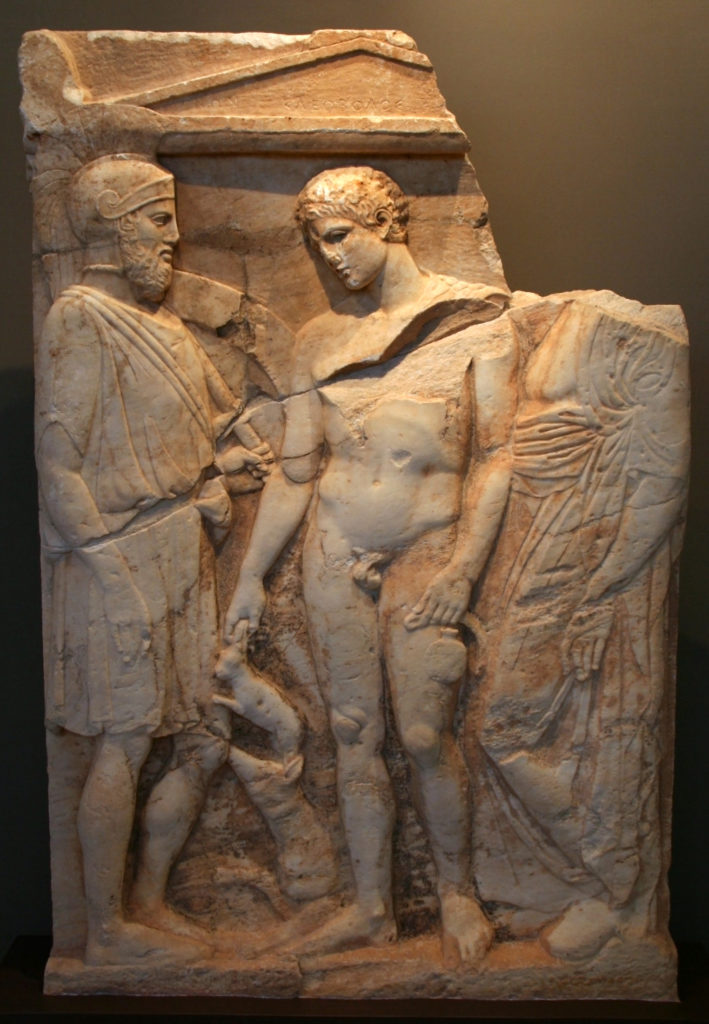
Funeral Stele of Menon and Kleobolos, Greek, late 5th–early 4th century BCE, marble. The Archaeological Museum of Brauron, acc. no. BE 6
While these types of courtship depictions are rare in funerary monuments, the eight Classical tombstones mentioned above, when considered in terms of the close association between courtship and hares and their connection to hunting in Greek art, give a context through which Antaios Meilesios’s tombstone can be reconsidered. The presence of the hare, underscored by the hunting dogs at the men’s feet, makes it clear that Antaios and his unnamed companion were in a romantic relationship and that this relationship was important enough to commemorate on this funeral stele in a clear but subtle way. The iconography on Attic vases and tombstones was so well established from the Classical and earlier periods that it was still used on tombstones carved in the Roman period, like this one. Whether Antaios and his companion lived together in a relationship that was known to all their friends and family, or if they lived apart, cannot be determined here. It can be asked, however, why is the name of the other man missing? There are many possible explanations; perhaps after Antaios died, his companion entered into another relationship and was not buried in the same location, if he did not move away from Attica entirely. Or perhaps after both men had died, their surviving family members and heirs did not make the effort to have the second man’s name carved on the tombstone. There is no indication on the stone that any attempt was made to carve (or erase) a second name from the stone.
Closing Reflections
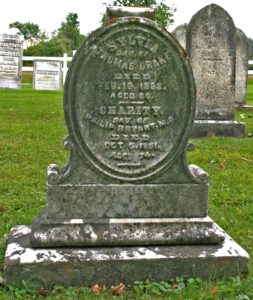
Dual Tombstone of Charity Bryant and Sylvia Drake in Weybridge Hill Cemetery, American, ca. 1868, stone. Weybridge Hill Cemetery. Image courtesy of the Henry Sheldon Museum.
The stele of Antaios Meilesios was first put on display at the Walters Art Museum in 2018, almost a century after it was acquired. The stele can serve as a reminder to museum visitors that people in the past loved each other in the same ways as people today, even if not always able to totally express themselves—their gender identities and sexualities were as complicated as those of individuals living in the twenty-first century. Antaios Meilesios’s monument is also a representation of a type of relationship that is not frequently seen, or at least not understood, in the art on display—and representation matters. We may never know how many same-sex couples were commemorated together on tombstones prior to the modern era, but it is certain that Antaios’s tombstone is not the only example (fig. 7).[30] Others are probably preserved but without enough evidence to make the relationship clear. A hint, like the hare held by Antaios’s companion, is needed to help recover these romantic connections that might otherwise be forgotten.
[1] Brummer inventory no. P658; Brummer Gallery Records, Cloisters Archives Collections, the Metropolitan Museum of Art, New York. Stickers bearing the inventory number “P658” were preserved on the stele until 2018, and the Brummer Gallery inventory card includes a pencil sketch of the object that, while highly simplified, shows that this is the same object. Brummer purchased the stele in 1923 from “Geladakis,” possibly the dealer Elias Geladakis who was based in Paris.
[2] Nothing further is known about the stele’s early history or findspot, although the golden patina on the stone supports the idea that it is marble from Mount Pentelikon (a marble source local to Attica), and the carving is consistent with Roman-period Attica.
[3] The inscription is briefly published as Inscriptiones Graecae II2 9391a. Non-citizen residents of Athens from Miletus, a city on the coast of modern Turkey, are commonly represented on Greek tombstones, and “Meilesios” (a variation of the more common “Milesios”) indicates that Antaios is also from Miletus. For more on Milesians in Athens, see Celina L. Gray, “Self-Representation of the Milesioi on the Sculpted Gravestones of Roman Attica” (PhD thesis, University of California, Berkeley, 2002).
[4] There are many possible interpretations of the palm trees, which may symbolize a location (whether the “East,” the island of Delos, or a sacred space); the deities Artemis and Apollo, or their mother Leto; fertility (because the tree is always leafy, although the date fruit does not typically grow in Greece); women; victory; or sexual interest or activity. For discussions of these interpretations and more, see Helena Fracchia Miller, The Iconography of the Palm in Greek Art: Significance and Symbolism (PhD thesis, UC Berkeley, 1979); Christiane Sourvinou-Inwood, “Altars with Palm-Trees, Palm-Trees and ‘Parthenoi,’” Bulletin of the Institute of Classical Studies 32 (1985): 125–46; and Fanny Michel-Dansac and Annie Caubet, “L’iconographie et le symbolisme du palmier dattier dans l’Antiquité (Proche-Orient, Égypte, Méditerrané orientale),” Revue d’ethnoécologie 4 (2013): 1–16. Another reading of the palm trees in this instance could be that they indicate an agricultural occupation of one or both of the men, as seems to be the case for a Roman-period Attic tombstone of Zosas and Nostimos, also Milesians, who may be interpreted as farmers based on the cow shown between them (Marathon, Archaeological Museum, acc. no. BE 13). Phoenix (Φοῖνιξ) was the Greek name for the date palm and was also used as a given name, so a final, although remote, possibility is that Phoenix was the given name of the man on the right. For Phoenix as a given name, see the fifteen instances from the Archaic to the Roman periods listed in the Lexicon of Greek Personal Names updated at http://www.seangb.org. Slight variations of the word “phoenix” were also, however, used for the date fruit, a shade of purple, and the Phoenicians.
[5] For overviews of the topic, see Kenneth J. Dover, Greek Homosexuality (Cambridge, MA: Harvard University Press, 1978); Wayne R. Dynes, “Introduction,” in Homosexuality in the Ancient World, ed. Wayne R. Dynes and Stephen Donaldson (New York: Garland, 1992), vii–xvii. The word “same-sex” is used throughout this note as the most inclusive term to describe a relationship between two men or two women, although it must be acknowledged that this does not capture the possible variety and nuance of the relationships under discussion; see M. E. Ficarra, Olivia Valcarce, and Sharon Williams, “Language of Difference: Writing about Gender and Sexuality,” Nesbitt-Johnston Writing Center, Hamilton College, especially: “Same-sex: can be used as an adj. to modify words like ‘couple’ or ‘marriage.’ It is often more accurate and inclusive than ‘gay’ or ‘lesbian’ as it can refer to either gender and includes bisexual people in same-sex relationships.”
[6] Arguably, the most famous example in literature is Plato’s Symposium, written in the early fourth century BCE about a symposium (elite male drinking party) that would have happened in the late fifth century BCE, where the attendees give speeches about love. The symposium is hosted by Agathon, who was known to have been in a relationship with another adult man, Pausanias. Along with a discussion of older men courting boys and the attempted seduction of the philosopher Socrates by the statesman and general Alcibiades, there is a story told by the character of the comedian Aristophanes, in a humorous albeit serious way, that describes same-sex love, whether between men or women, as being as natural as love between a man and a woman. For overviews of courting among men on Greek vases, see for example H. Alan Shapiro, “Courtship Scenes in Attic Vase-Painting,” American Journal of Archaeology 85, no. 2 (1981): 133–43; Eva C. Keuls, The Reign of the Phallus: Sexual Politics in Ancient Athens (Berkeley: University of California Press, 1985), esp. chap. 11, “The Boy Beautiful: Replacing a Woman or Replacing a Son?” 274–99.
[7] Keuls observes that “although male homosexuality was widely practiced, in the Classical period it was, at the most, only half-heartedly condoned” (The Reign of the Phallus, 275).
[8] See note 6 above.
[9] Examples include a mid-sixth-century BCE amphora in Munich (Antikensammlung, acc. no. 1468), which shows an older man groping a younger man; and an early fifth-century BCE kylix by the Briseis Painter in Paris (Musée du Louvre, acc. no. G 278) that shows an older bearded man kissing a boy.
[10] See Walters Art Museum, acc. no. 48.2115, Kylix with Boar Hunting Scene, ca. 480 BCE, where the inscription around the nude hunter reads “Aristarchos is beautiful.” Another example at the Walters, acc. no. 48.2121, ca. 475–450 BCE, shows a nude dancer and a komast (reveler) with the word “beautiful one” written at the youth’s head on each side.
[11] Judith M. Barringer, The Hunt in Ancient Greece (Baltimore: Johns Hopkins University Press, 2003) 89–95. See the late sixth-century BCE bell krater by the Berlin Painter in Paris (Musée du Louvre, acc. no. G 175) showing the youth Ganymede holding a rooster he had received as a love gift.
[12] Barringer, The Hunt in Ancient Greece, 95–98; see also Alain Schnapp, “Eros the Hunter,” in A City of Images: Iconography and Society in Ancient Greece, ed. Claude Bérard et al., trans. Deborah Lyons (Princeton, NJ: Princeton University Press, 1989) 71–87. An early fifth-century BCE kylix, attributed to the Antiphon Painter, in New York (Metropolitan Museum of Art, acc. no. 96.9.36) has one scene on the exterior rim showing a young man presenting another with a hare as a love gift.
[13] Barringer, The Hunt in Ancient Greece, 70–71. Hunting, like erastes-eromenos relationships, had an association with initiation into aristocratic society. For fuller explorations of the iconographic connection between hunting and male courtship in Greek art, see Alain Schnapp, Le chasseur et la cité: Chasse et érotique dans la Grèce ancienne (Paris: Albin Michel, 1997); and Barringer, “Eros and the Hunt,” in The Hunt in Ancient Greece, 70–124.
[14] See Anthi Dipla and Dimitris Paleothodoros, “Selected for the Dead: Erotic Themes on Grave Vases from Attic Cemeteries,” in Encountering Imagery: Materialities, Perceptions, Relations, ed. Ing-Marie Back Danielsson, et al. (Stockholm: Department of Archaeology and Classical Studies, Stockholm University, 2012), 209–33.
[15] Janet Burnett Grossman provides a recent and thorough overview of funerary sculpture in Athens from the Classical through Roman periods in The Athenian Agora, Vol. 35: Funerary Sculpture (Princeton, NJ: American School of Classical Studies at Athens, 2013), 9–64; for fuller treatments, see Christoph W. Clairmont, Classical Attic Tombstones, 7 vols. (Kilchberg, Switzerland: Akanthus, 1993), and Derk W. von Moock, Die figürlichen Grabstelen Attikas in der Kaiserzeit: Studien zur Verbreitung, Chronologie, Typologie und Ikonographie (Mainz: P. von Zabern, 1998). It must be noted that the style was not completely static from the Classical to the Roman periods, but the continuation of elements of imagery and composition are strong and notable.
[16] See Harvard Art Museums, acc. no. 1977.216.2185, Stele of a Lady and Her Servant, first century BCE–first century CE. A more ambiguous relationship is represented on a stele in New York, Metropolitan Museum of Art, acc. no. 36.11.1, Marble Grave Stele of a Young Woman and Servant (or “younger sister”), early fourth century BCE.
[17] See Walters Art Museum, acc. no. 23.176, Funerary Stele with a Seated Woman and Children, fifth century BCE; and Harvard Art Museums, acc. no. 1977.216.2186, Funerary Stele, Roman Imperial period.
[18] See Walters Art Museum, acc. no. 23.185, Funerary Relief with Eight Figures, fourth century BCE.
[19] See Lucia Nováková and Monika Pagáčová, “Dexiosis: A Meaningful Gesture of the Classical Antiquity,” Ilaria International Review 6, no. 1 (2016): 207–22.
[20] Sian Lewis, The Athenian Woman: An Iconographic Handbook (London: Routledge, 2002), 193. At least one other recent scholar has been open to interpreting certain elements of tombstones as examples of erotic courtship; see Barringer, The Hunt in Ancient Greece, 179–81.
[21] For example, see Clairmont, Classical Attic Tombstones, 2.155, vol. 2, 103–4: comrades, brothers, or family members; no. 2.156, vol. 2, 104–6: brothers, comrades, or close friends; and 2.455, vol. 2, 583–84: brothers, friends, or Altersgenossen (men of the same age or “contemporaries”).
[22] Clairmont, Classical Attic Tombstones, no. 2.183, vol. 2, 119–20. Compare Lewis, The Athenian Woman, 194, on the same stele: “The presence of the hare, nevertheless, suggests a courting gift.”
[23] Clairmont, Classical Attic Tombstones, no. 2.892, vol. 2, 783–84.
[24] The interpretation of this image and inscription is admittedly difficult. The inscription reads: “Polykrates, son of Polykrates, from the deme of Oe. / Planthe, daughter of Kallimachos, from the deme of Melite. / (Later addition) Thesmothetia, daughter of Ameinias, from Piraeus.” The third line for Thesmothetia was added later, and in a different hand. Because only two adults are shown, it is unclear exactly which of the two women is depicted.
[25] Sylvia M. Welsh, “An Attic Grave Lekythos,” The Journal of Hellenic Studies 26 (November 1906): 229–34; Clairmont, Classical Attic Tombstones, no. 4.190, vol. 4, 33–34.
[26] Clairmont, Classical Attic Tombstones, no. 1.695, vol. 1, 415–16.
[27] National Archaeological Museum, Athens, acc. no. 898. Clairmont, Classical Attic Tombstones, no. 1.810, vol. 1, 448–49. This stele, like that of Eratoxenos and Megisto, is problematic to interpret due to the obvious difference in the depicted ages of the two figures, though in this case the body language of the child seems more like that of a servant. In this instance, Clairmont dismisses the notion that the hare was a love gift, although it had been suggested by another scholar. If the figures are master and servant, then the interpretation of the scene would be that Telesias received the hare as a gift from an erastes who is not depicted.
[28] Antikenmuseum Basel, acc. no. BS 233/S 175 and Archaeological Museum of Brauron, acc. no. BE 812; early fourth century BCE. Clairmont, Classical Attic Tombstones, no. 1.289, vol. 1, 296–98. This could also be interpreted as Euthesion returning from a hunt, but the connection between hunting and courtship is noted earlier in this paper. Hunting dogs frequently appear in courting scenes, see Barringer, The Hunt in Ancient Greece, 84, 90.
[29] National Archaeological Museum, Athens, acc. no. 794. Clairmont, Classical Attic Tombstones, no. 1.200, vol. 1, 256–57. No inscription is preserved to identify the youth.
[30] A well-known example of a shared tombstone that commemorates a same-sex relationship is that of Charity Bryant and Sylvia Drake, who were accepted by many friends and acquaintances as a married couple in nineteenth-century Vermont. Although the inscription on the tombstone is relatively brief, giving their names, the names of their fathers, their ages, and the dates of each of their deaths, extensive contemporary literature, including letters and diaries, are explicit about their relationship and speak of the two women as “married” to each other. See Rachel Hope Cleves, Charity and Sylvia: A Same-Sex Marriage in Early America (Oxford, 2016), and Sarah Kaplan, “The Improbable, 200-Year-Old Story of One of America’s First Same-Sex ‘Marriages,’” The Washington Post, March 20, 2015.
